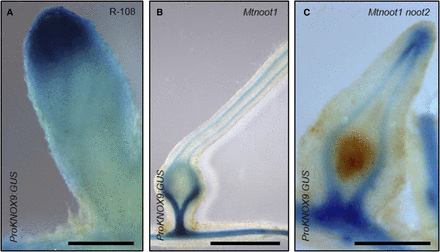Mtnoot1, Mtnoot2 and the identity of symbiotic nodules
The Mtnoot1 noot2 homeotic symbiotic nodule mutant sheds light on the origin of the nodule symbiotic organ.
Symbiotic interactions between legume plants and rhizobia result in the formation of a specific symbiotic organ called the nodule. In this symbiotic organ bacteria fix atmospheric nitrogen to the benefit of the plant. Legume plants can thus develop without the addition of environment and health damaging nitrogen fertilizers. The early steps of the plant-rhizobia are well described but the mechanisms supporting nodule identity maintenance remain poorly described. In Medicago truncatula, the loss-of-function of the MtNODULE ROOT1 (MtNOOT1) gene triggers a partial loss of nodule identity. This later is characterized by the development of roots arising from nodule vascular meristems. In this new work, we report the identification and the characterization of the MtNODULE ROOT2 (MtNOOT2) gene and its role in nodule identity. MtNOOT2 is a paralog of MtNOOT1 and is mostly expressed in the nodule apical meristem. The Mtnoot2 mutants do not present any symbiotic phenotype; however, in the Mtnoot1-Mtnoot2 double mutant the nodule identity is completely lost and is accompanied by drastic changes in symbiotic, defence and root apical meristem marker gene expression. The homeosis is characterized by a complete nodule-to-root identity reversion, confirms that the nodule vasculature is ontologically related to root and highlights the evolutionary origin of the symbiotic organ. Moreover, theMtnoot1-noot2 double mutant develops only non-fixing root-like structures that are no longer able to host symbiotic rhizobia, highlighting the crucial role of organ identity for the symbiotic infection.
Magne et al.(2018) MtNODULE ROOT1 and MtNODULE ROOT2 are essential for Medicago truncatula indeterminate nodule identity. Plant Physiology, 178(1):295-316.

